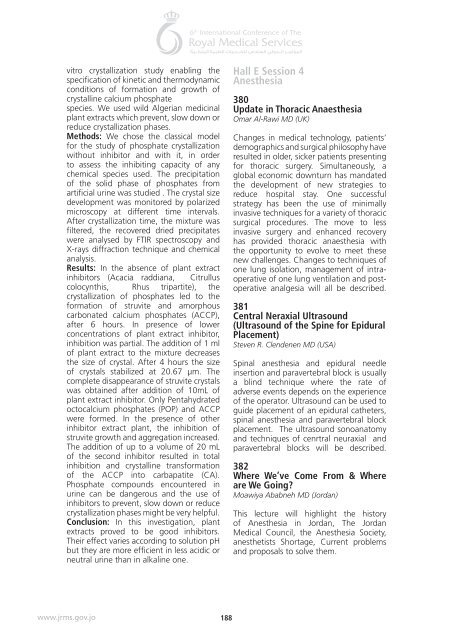Abstract book 6th RMS 16.indd
Abstract book 6th RMS 16.indd
Abstract book 6th RMS 16.indd
You also want an ePaper? Increase the reach of your titles
YUMPU automatically turns print PDFs into web optimized ePapers that Google loves.
vitro crystallization study enabling the<br />
specification of kinetic and thermodynamic<br />
conditions of formation and growth of<br />
crystalline calcium phosphate<br />
species. We used wild Algerian medicinal<br />
plant extracts which prevent, slow down or<br />
reduce crystallization phases.<br />
Methods: We chose the classical model<br />
for the study of phosphate crystallization<br />
without inhibitor and with it, in order<br />
to assess the inhibiting capacity of any<br />
chemical species used. The precipitation<br />
of the solid phase of phosphates from<br />
artificial urine was studied . The crystal size<br />
development was monitored by polarized<br />
microscopy at different time intervals.<br />
After crystallization time, the mixture was<br />
filtered, the recovered dried precipitates<br />
were analysed by FTIR spectroscopy and<br />
X-rays diffraction technique and chemical<br />
analysis.<br />
Results: In the absence of plant extract<br />
inhibitors (Acacia raddiana, Citrullus<br />
colocynthis, Rhus tripartite), the<br />
crystallization of phosphates led to the<br />
formation of struvite and amorphous<br />
carbonated calcium phosphates (ACCP),<br />
after 6 hours. In presence of lower<br />
concentrations of plant extract inhibitor,<br />
inhibition was partial. The addition of 1 ml<br />
of plant extract to the mixture decreases<br />
the size of crystal. After 4 hours the size<br />
of crystals stabilized at 20.67 μm. The<br />
complete disappearance of struvite crystals<br />
was obtained after addition of 10mL of<br />
plant extract inhibitor. Only Pentahydrated<br />
octocalcium phosphates (POP) and ACCP<br />
were formed. In the presence of other<br />
inhibitor extract plant, the inhibition of<br />
struvite growth and aggregation increased.<br />
The addition of up to a volume of 20 mL<br />
of the second inhibitor resulted in total<br />
inhibition and crystalline transformation<br />
of the ACCP into carbapatite (CA).<br />
Phosphate compounds encountered in<br />
urine can be dangerous and the use of<br />
inhibitors to prevent, slow down or reduce<br />
crystallization phases might be very helpful.<br />
Conclusion: In this investigation, plant<br />
extracts proved to be good inhibitors.<br />
Their effect varies according to solution pH<br />
but they are more efficient in less acidic or<br />
neutral urine than in alkaline one.<br />
Hall E Session 4<br />
Anesthesia<br />
380<br />
Update in Thoracic Anaesthesia<br />
Omar Al-Rawi MD (UK)<br />
Changes in medical technology, patients’<br />
demographics and surgical philosophy have<br />
resulted in older, sicker patients presenting<br />
for thoracic surgery. Simultaneously, a<br />
global economic downturn has mandated<br />
the development of new strategies to<br />
reduce hospital stay. One successful<br />
strategy has been the use of minimally<br />
invasive techniques for a variety of thoracic<br />
surgical procedures. The move to less<br />
invasive surgery and enhanced recovery<br />
has provided thoracic anaesthesia with<br />
the opportunity to evolve to meet these<br />
new challenges. Changes to techniques of<br />
one lung isolation, management of intraoperative<br />
of one lung ventilation and postoperative<br />
analgesia will all be described.<br />
381<br />
Central Neraxial Ultrasound<br />
(Ultrasound of the Spine for Epidural<br />
Placement)<br />
Steven R. Clendenen MD (USA)<br />
Spinal anesthesia and epidural needle<br />
insertion and paravertebral block is usually<br />
a blind technique where the rate of<br />
adverse events depends on the experience<br />
of the operator. Ultrasound can be used to<br />
guide placement of an epidural catheters,<br />
spinal anesthesia and paravertebral block<br />
placement. The ultrasound sonoanatomy<br />
and techniques of cenrtral neuraxial and<br />
paravertebral blocks will be described.<br />
382<br />
Where We’ve Come From & Where<br />
are We Going?<br />
Moawiya Ababneh MD (Jordan)<br />
This lecture will highlight the history<br />
of Anesthesia in Jordan, The Jordan<br />
Medical Council, the Anesthesia Society,<br />
anesthetists Shortage, Current problems<br />
and proposals to solve them.<br />
www.jrms.gov.jo<br />
188

















